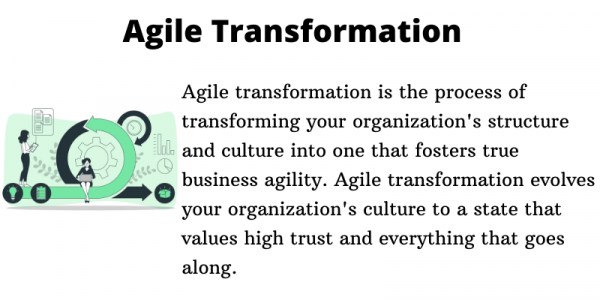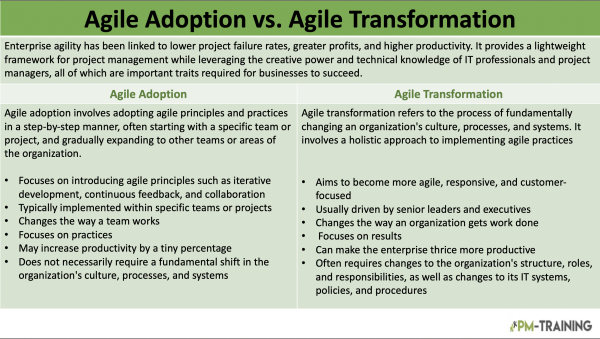Ready to learn about Agile transformation?
Well, you’re not the only one!
About half of all businesses worldwide use Agile practices.
But why?
For beginners, enterprise Agility has been linked to lower project failure rates, greater profits, and higher productivity. It provides a lightweight framework for project management while leveraging the creative power and technical knowledge of IT professionals and project managers, all of which are important traits required for businesses to succeed.
(Coincidence? Maybe not.)
For most businesses in 2022, what rings true is ‘Survival of the Fittest
So it makes sense for organizations to be Agile.
Let’s take a look at business agility and how an organization can undergo an Agile transformation. As an added bonus, we’ll also give away some solutions to hurdles expected to be met on your Agile transformation journey to better prepare your organization for a smooth transformation journey.
So let’s go!
What is Agile?
Most times, when people think of Agile, they think of Agile software development or Agile management. While they’re not wrong, that just isn’t the whole picture!
At the core, Agile is a combination of every Agile principle and value listed in the 2001 Agile manifesto. These principles helped Agile development and management come into existence.
When the Manifesto came about, these ideas revolutionized the way we look at project management!
Think of that moment as similar to when Darwin published On the Origin of Species, ushering the concept of evolution into the mainstream!
Before Agile, the software development process took months and even years to be completed. When the Agile approach rolled out, software development evolved surprisingly fast.
Now software developers could produce a piece of software in just a few weeks, using the Agile methodology.
Over the years, the Agile framework has evolved further and led to different Agile management methodologies like Scrum, Kanban, XP, and many more Agile species.

Agile Best Practices
In Agile best practices, its core is small iterations, constant work to revise and validate work, and also improve processes at every checkpoint. This is easily applied to Product Management, especially in your specific set of managing and improving your product backlog. Let’s unfold some general best practices to perform effective Agile transformation:
- Work in small Iterations
Working in small iterations allows for identifying the current high-priority stories on your backlog, elaborating them, and then identifying the next set of high-priority stories.
- Revise and Validate
Every two weeks or so, ensure to look at your prioritization and review it with REAL customers while making sure that you’re listening to what they’re NOT saying. Use both unspoken and spoken content to revise the priorities on the backlog that you already have. If something that wasn’t elaborated moves up, expand upon it in detail.
- Improve your process
Every two weeks (or depending on your iteration plan), ask yourself and your teams, “What is it that we’re doing right?”, “What is it that we can improve? “, and “What should we stop doing RIGHT NOW that is causing problems?”.
Applying general Agile principles to Project Management practices isn’t as daunting as many people think…in fact, it’s a necessity if the development team you are working with is using Agile/SCRUM practices themselves.

Now let’s walk through how the Agile method plays a big role in Agile transformation.
Understanding Agile Transformation
Agile transformation is the process of transforming your organization’s structure and culture into one that fosters true business agility. Agile transformation evolves your organization’s culture to a state that values high trust and everything that goes along; a complete makeover.
However, Agile transformation isn’t all about merely showing your teams how to use a Scrum board.
That’s like an eerie optical illusion tricking the brain into thinking one is always looking at the front- even as it spins!
At first, it looks real, but the illusion quickly wears off once the depth of information becomes too strong to ignore and you see the image for what it is!
The same can be said about Agile transformation.
Your organization’s focus shouldn’t just be on ‘looking Agile’… It needs to follow the Agile way, right down to its very core. And this entails:
- Thinking Agile: adopting the Agile mindset
- Being Agile: creating self-organizing teams
- Living Agile: creating a unique work culture of innovation
- Leading Agile: reducing redundant layers of management
However, ensure you don’t mistake Agile transformation for Agile Adoption. They share similar characteristics but definitely not the same.
Agile Adoption vs. Agile transformation
Agile adoption entails adopting Agile for certain work processes resulting from Agile development software whereas Agile transformation is a complete Agile adoption across an entire organization.

Agile adoption focuses on following a few Agile practices or processes at the team level. And in most cases, when a team says they’re ‘adopting Agile’, that means they’re trying to mimic an Agile or Scrum team.
Let’s unpack the key differences between Agile adoption and transformation:
- Agile adoption gets done with other people’s practices while Agile transformation involves creating your own using Agile methodology
- Agile adoption changes the way a team works, whereas Agile transformation changes the way an organization gets work done
- Agile adoption is focused on practices, while Agile transformation focuses on results
- Agile adoption is short-lived while Agile transformation focuses on a longer horizon
- Agile adoption may increase productivity by a tiny percentage, but transformation can make your enterprise thrice more productive!
Benefits of Agile Transformation
Organizations that complete Agile transformation witness continuous improvements in project success, increased flexibility, better team communication, and increased transparency. Let’s unfold the benefits of Agile transformation listed below:
- Higher project success
Here’s a fun fact for you:
When your organization goes on an Agile transformation journey, their projects are 2x as successful as compared to traditional projects!
Please note: Here, ‘success’ means the Agile team delivered everything that was promised to its customers.
- Flexibility
Traditional project management entails projects having well-detailed and fixed plans. Once there’s a plan in place, there is no room for change. This method can be constraining for many team members, who would naturally want a way out!
But when your organization uses Agile values, your team will no longer feel restricted. They will be free to create solutions their way, the Agile way! Your team gains the flexibility to test different solutions to see what works and what doesn’t. And the organization gains the agility to switch its business strategy to meet market demands.
- Continuous improvement
Agile teams are continuously learning and collaborating throughout regular sprints (short bursts of work ranging from 2 to 4 weeks). At the end of each sprint, they review the performance and seek ways to improve. Continuous improvement allows for everyone to expand their knowledge, and put their learning to good use during a sprint.
- Better team communication
Agile management establishes many important meetings in the workplace. However, these meetings aren’t like regular meetings. Each of them has a specific purpose that can help different Agile teams share knowledge among themselves.
- Increased transparency
With regular meetings comes regular ongoing project updates. As a result, every Agile team member knows what is going on within the organization. And leadership teams can set reasonable expectations for their team, as they already know what their team members are capable of.
Disadvantages of Agile Transformation and Solutions
When implementing an Agile transformation for your entire organization, it’s easy for missteps to occur. Taking on two-week iterations and other experimental approaches to increase production can help inspire creativity and enthusiasm—but are not without risk.
Here are the three disadvantages of Implementing Agile transformation all project managers and IT professionals ultimately face:
- Lack of processes, limited documentation, and no finite end
The ingrained freedom and independence of the Agile transformation can be refreshing. Especially for your more self-assured software developers (or any other subject matter expert in your team) who welcome the idea of forging ahead with minimal planning.
However, the see-as-you-go nature of Agile also allows teams to get easily sidetracked along the process. Often, when you proceed without adequate documentation, scope creep becomes inevitable.
Once there’s no finite end in sight, measuring progress can also be a daunting challenge.
These concerns often lead to frustrations, skipped tasks, and missed deadlines.
Solution: Devise ways to measure growth and share your team’s progress
It can be as simple as setting KPIs and OKRs within your Agile methodology or building a product roadmap with your team. Project management tools can help you and your team create an analytical basis for decision-making while gaining immense insight and clarification into each subsequent product launch.
Be sure to establish requirements within your Agile framework as that also helps when onboarding new members to your team—letting them know any necessary project details upfront and how to better focus their attention on what matters most.
- Long-term projects suffer from incremental delivery
Compared to other methodologies, the Agile methodology lacks enormous checks and balances to safeguard less experienced developers and team members. Because Agile methodology doesn’t have a formal design phase, long-term project development can be more chaotic.
And since Agile is based on the premise that teams won’t always know what their end result will look like (or the next few delivery cycles ahead as the case may be) it becomes difficult to accurately predict the cost, time, or resources needed at the beginning of a project.
Solution: Prioritize the must-have items within each sprint and act accordingly
By scoping out and ranking your organization’s Agile projects early on, you and your team can be in a better position to assess which opportunities are best worth pursuing.
- Team collaboration level can be difficult to maintain
Agile is meant to be an empowering process. When it is successfully implemented, project teams are adept at self-organization and cross-functionality. However, Agile requires continual collaboration, additional time, and greater commitment.
When done correctly, the Agile methodology can be an engaging and transformative system. But it demands a firm commitment from everyone involved in your project, including your customers, for it to be successful.
Sidestepping requirement analysis, design planning, and the other developmental procedures found in the more traditional methodologies outside of Agile may initially free up time. But in the absence of linear phase completion tactics, bringing your team together regularly to discuss and evaluate what is working (and what is not) is paramount.
Solution: Align your team with the use of the Scrum board
The use of a scrum board is one of the most effective ways to track project status before each sprint. Scrum boards provide your team with visual representations of your current sprint—including a list of in-progress tasks, a prioritized backlog of product features, and any tasks being verified or tested.
Tips for Agile Transformation
Now that you’ve walked through the nuances of Agile transformation for organizations, let’s look at the key tips to help your organization navigate its Agile transformation seamlessly:
- Set clear goals
It is important to state and define your end goal for your transformation journey. Your organization can accomplish Agile practices first based on the unique environment in your organization.
The goal should specifically pertain to working faster and making better products. It is helpful if you have a third-party advisor document your business practices and recommend the best way Agile can be adopted.
- Build the right team for the right transformation
Agile processes affect each corner of your organization and appointing key employees to a transformation is a must. Your team members should advocate the process in order for it to be successful in different parts of your organization. This transformation team will guide each Agile process and ensure changes are implemented at each stage of the project.
- Measure your progress before going Agile
The only way to ensure your Agile transformation is working for your organization is when the process gets measured. The processes must be assessed and monitored regularly so that modification can be done.
Before going Agile, your organization must ensure they know how to track progress and report when adopting Agile methodology. The creation of strong teams to achieve ideal success should be clear to both managers and employees. Your team’s satisfaction should be considered utmost for Agile to work successfully.
- Implement best practices gradually
Following the industry’s best practices makes Agile practices more efficient. The first step taken should be the smallest change needed to achieve it. Adopting little changes for your organization can lead to increased productivity.
- Scale up to grow
Foundation for Agile methodology laid by organizations compels leaders to determine how it will scale beyond the pilot team. Focus on how much value Agile is adding to your organization.
With extensive experience and industry expertise with Agile, your organization can leverage Agile scrum teams to speed up changes throughout your organization. Implementing Agile methodology is a great way to set your organization up in its Agile transformation journey because it can quickly redefine and empower your business transformation, making it ready to fit into cut-throat competition.
Agile transformation methodology is continuously evolving, and it never stops!
So, go the Agile way!
